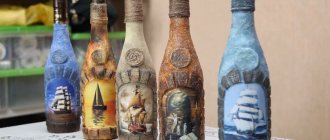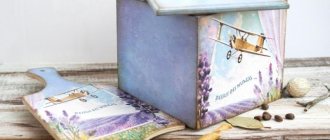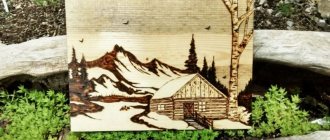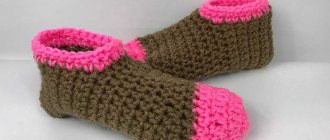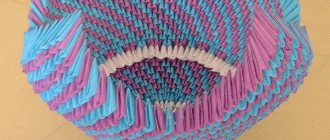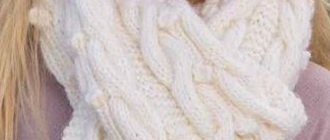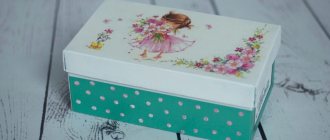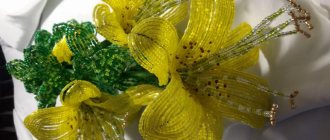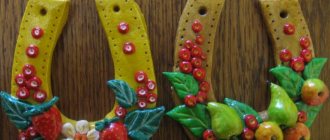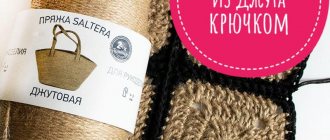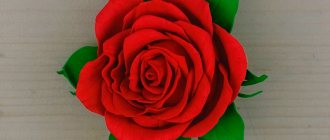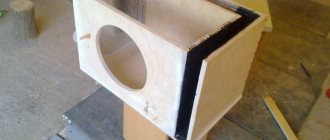The popular technique of decoupage is a surprisingly elegant, but at the same time absolutely uncomplicated creative direction. Its essence comes down to decorating furniture, household items and wardrobes with all kinds of colorful applications. Images cut from napkins, newspapers and other paper sources are fixed using several layers of varnish, thereby creating the effect of complete and seamless fusion with the surface.
Many novice needleworkers who set out to master decoupage techniques are interested in the question of what objects can be applied to. Absolutely any questions are answered by professionals. The most inconspicuous thing can be transformed beyond recognition. All the things that can be found in the attic of a grandmother’s house or in a chest in her bedroom - boxes, bracelets, flowerpots, photo frames, dishes, candles - can become a unique work of art if they are skillfully given a second life. You don’t need much for this, just patience and imagination.
Decoupage is an incredibly exciting creative technique. It does not require the purchase of expensive materials or any professional skills. As you master this amazing decorative trend, you will learn how to turn boring, everyday things into unique masterpieces - intricate, spectacular and inimitable!
This lesson presents decoupage master classes for beginners using napkins with step-by-step photographs.
To date, decoupage masters have mastered many amazing techniques - this is artificial aging, and the application of 3D images, and gilding, and craquelure coating, and other man-made miracles. Creative people clearly have a lot of ingenuity!
Application of decoupage technique
Most often, this decoration option is used to create unusual things designed to charmingly decorate rooms in rural styles: Provence or country. Pretty items are also suitable for creating a feeling of coziness in a rather rough loft.
The technique is used to create completely unusual gifts from absolutely familiar objects: boxes, bread bins, cutting boards, wine bottles, New Year's glass balls. Decoupage will also give old furniture a second life, turning it into a real work of art.
Features of the design of round surfaces
Surfaces with curves and slippery glass or glazed ceramic surfaces require a special approach to the technique. New Year's bottles decorated with appliqués look very elegant.
A gift option for expensive alcohol in a retro style will pleasantly surprise friends and employees. Decoupage of bottles with napkins, just like decoupage of plates with napkins, requires a different approach to application.
What is decoupage?
The beautiful word comes from the French language, where it is used as a verb to cut.
Currently, this concept refers to decorating a surface by gluing decoupage pictures.
Decoupage for beginners is accessible to anyone, regardless of age and preferences.
Getting ready for Easter
On the eve of the Easter holidays, a special theme arises in decorating objects, including Easter eggs. Decoupage of Easter eggs involves applying a beautiful ornament to a pre-boiled egg.
We will not use regular glue, as it penetrates through the porous shell. And for gluing, fresh, raw egg white is perfect. It is tapped a little to break up the fibers and applied with a brush to the base.
Attach the cut out picture, let it dry a little and cover the surface with protein again, but with a picture. The protein reliably fixes the decor, does not fade, does not give off odor and lasts for several days.
Materials
To start turning boring things into unusual objects, you will need to take care of the tools and materials that will help you create an amazing creation.
A novice needlewoman will need:
- basis for applying the image;
- paper napkins;
- glue;
- clear nail polish;
- paints;
- tassels.
All of this can be purchased at stores that specialize in selling craft supplies, or you can find most of the items on this list at home. For the first work, it is not at all necessary to purchase rather expensive professional materials.
The basis
Any relatively smooth and even surface can be used as a basis for design. However, for beginning craftswomen, it is better to take a plastic or glass horizontal or vertical surface. Curved things like Christmas tree decorations, bread boxes, round boxes, decoupage bottles for beginners are best left for later, when experience allows you to decorate such complex details with pictures.
A little history
Back in the 12th century, poor Chinese people invented a way to decorate their meager furniture. They glued fabric patterns to the doors of the facades and covered them on top with several layers of protective varnish. Centuries later, this technique migrated to Europe. Craftsmen began to sell skillful copies of expensive inlaid boxes.
Decoupage helps create masterpieces Source www.livemaster.ru
With the advent of printing, it became much easier to produce competitive products. People liked things decorated with oriental motifs and pastoral designs. Soon the new technique acquired the name “decoupage”. Translated from French, it means “cutting.”
A simple way to give old furniture a second life Source kitchenremont.ru
Napkins
To create stylish antique items, you can use special napkins, but a good option for saving the family budget would be to use ordinary multi-layer paper napkins. For decoration, you only need their upper part with a beautiful image.
Note!
- Ideas for LD (a girl’s personal diary): step-by-step instructions for making it yourself, photo reviews of the best options
Educational soft books made of felt: materials for making, detailed instructions + reviews of plots for books (100 photos)
Original do-it-yourself valentines - design options, necessary materials, master class for DIY work
Often instead of napkins, newspaper and magazine clippings, postcards and other suitable images are used.
However, for the very first works it is better to buy napkins for decoupage. They have a special density that helps to glue the image evenly or, if necessary, quickly remove it. The paper of such napkins does not tear or deform when applied.
How to choose the right drawing
When choosing pictures, pay attention to:
Note!
Kinusaiga technique - TOP-140 photos of the best ways to create crafts using the Kinusaiga technique with your own hands + instructions for beginners
- Do-it-yourself passe-partout - a master class with step-by-step do-it-yourself schemes. Making tips + photos of the best examples
- Amigurumi: features of do-it-yourself knitting technique. Step-by-step master class on making toys for beginners + 180 photos
- Stretching paper. Too thin will be easy to tear and inconvenient to work with;
- The top layer of napkins should be easy to separate, have a translucent structure, due to which an organic appliqué is obtained that imitates artistic painting;
- The degree of wetting, the formation of folds, irregularities;
- One of the advantages is the availability of the material and low price.
Glue
Decoupage for beginners from napkins will require the use of glue. In principle, this is one of the main elements of creating an unusual thing.
At first, you can buy regular PVA of the middle price category and slightly dilute it with water for better saturation of the picture. In the future, it is better to purchase special glue.
Varnish
Decoupage for beginners from napkins is completed by coating the surface with varnish, which will protect the applied pattern from the negative effects of the environment.
Note!
- Do-it-yourself bead brooch: photos of the best options, step-by-step master class on how to create it yourself, weaving patterns
Do-it-yourself felt toys - TOP-120 photos of toy ideas, do-it-yourself instructions for making them for beginners
- How to make a lapbook with your own hands: a detailed master class on how to make it yourself, reviews of lapbook elements
The best option would be water-based acrylic varnish. It dries quickly and does not smell much. To begin with, you can use regular construction varnish.
Sometimes a varnish with a craquelure effect is selected, giving the decorated surface a delightfully antique look.
Tools
The tools are:
- Sharp scissors, straight and curved.
- Stationery knife.
- Sandpaper for sanding the surface if something rough will be used as a base.
Note!
- Amigurumi for beginners - photos of the best toys, a master class on knitting items with your own hands step by step
- DIY bear costume: step-by-step master class for DIY sewing. Costume design options for the New Year
Bead weaving patterns for beginners - step-by-step instructions with photos and descriptions
A glass of water for washing your brushes will also come in handy.
Preparation
- The step-by-step instructions for beginners are quite simple. But the quality of the finished product is largely determined by the preparatory work.
- The wood is freed from knots and eyes, carefully sanded with sandpaper until a smooth surface is obtained.
- Glass, plastic and metal are degreased using alcohol or regular dishwashing detergent. Rust is carefully removed, damaged areas are lubricated with special compounds.
- The base prepared in this way is covered with any construction primer, ensuring better adhesion of the two materials.
- Painting the surface with white paint will help make the design more expressive and add additional depth.
While the primer and paint are drying (one by one, until completely dry), the drawings are prepared. To do this, suitable pictures are cut out from a napkin and freed from excess layers of paper.
Useful tips
To make decoupage decoration quickly and accurately, there are several small tricks when working with this decoration method. These tricks can also help avoid wrinkles on the product:
- All fragments of the pattern are pre-moistened with water using a spray bottle - with the help of moisture the napkin will stretch. If it has lost its shape, then you can carefully iron it, and then proceed to traditional decoupage methods. The entire further process is easier and faster.
- Fragments of the pattern can be moistened with varnish. The structure of the napkin will become more rigid, which means that wrinkles will be avoided. However, if this trick is used, then the glue can only be applied to the surface itself - the napkin will repel it.
- You can place a napkin on the surface and then start applying glue. More details about this method are in the video.
Applying an image
There are several ways to fix a drawing on a base. But the simplest thing will be simply gluing a picture.
Decoupage for beginners step by step with photos will help you visually evaluate this method of decoration.
The whole process looks like this:
- A picture is applied to the prepared surface.
- The entire piece is carefully coated with glue, starting from the center of the image and gradually moving towards the edges of the picture (if the layer of paper does not allow the glue to penetrate to the base, then the picture is glued like a regular applique, carefully leveling out the folds and fixing all the ends).
- Leave the almost finished product to dry completely.
- Several layers of varnish are applied on top. Sometimes up to a hundred layers are used to achieve the result, but for simple homework you can limit yourself to 4-6 layers. Each of them must be dried.
Basic Rules
A master class on decoupage technique will show the entire sequence of actions. It is not as complicated as it seems at first: the surface is primed, covered with paint, glue and an image are applied to it, and all this is varnished.
But before that, it’s better to learn the basic rules that will help you make a good craft the first time.
It is necessary to paint the entire surface that will be visible. For example, for a flower pot you will have to take care of painting the bottom and inside all the way to the ground, and maybe a little deeper. And if you plan to give the pot without flowers or greenery, then you will have to cover all surfaces with paint.
If imperfections are visible in the paint, you will have to repaint the entire surface, achieving the ideal tone.
Light background colors will help make the image more realistic and expressive. In addition to white, all pastel shades will look great.
Before applying each subsequent layer, the craft must be dry. Rushing through the creative process is a great way to ruin everything.
Small pictures are easier to apply. Therefore, for the first work it is better to use them. Before gluing, you should once again make sure that the picture is suitable for the selected area in size, color or subject. To do this, it is simply leaned against the base.
The glue is applied from the center to the corners, thoroughly covering the entire surface. The pattern is carefully smoothed out, straightening out all the folds.
Correction of minor bugs
Even experienced craftswomen can make mistakes. But most of them can be corrected before varnishing. Slightly damp paper can be gently smoothed out with your fingers or a wet brush. Unevenness in the dried picture can be removed with soft sandpaper.
Inhomogeneity of the background or blurry image can be corrected with a brush with suitable paint. It will also help create a smooth transition between the picture and the base, and create unusual splashes.
A photo of decoupage will demonstrate the charm of works in this design style and will inspire you to create something similar.
We eliminate flaws
If the surface is decorated with small torn fragments, from which it is necessary to obtain a single whole, straighten the edges of the fragments with a brush or fingers. If there is color unevenness somewhere, dilute the paint of the desired shade and paint over the translucent base.
When the surface is no longer very wet, but has not yet dried, you can use thin brushes and acrylic paints to draw in the details, add brightness and clarity.
The next step is to decorate the edges of the product. There are different approaches here. In some places you have to trim the edges evenly, painting the sides, in others you can wrap the napkin on the back side and glue it there. In general, this is also a whole science.
Getting it to the finish line is an equally creative process.
After this, you can leave the product to dry. To speed up the process, you can use a hair dryer, but you need to keep it at a considerable distance, move it all the time and make sure that it dries evenly. If after drying you see that there is a fold on the glued napkin, you can still fix it. Take fine-grained sandpaper and sand it. We act gently so as not to damage the drawing around.
